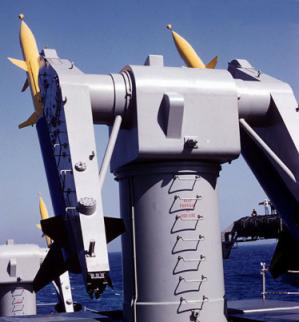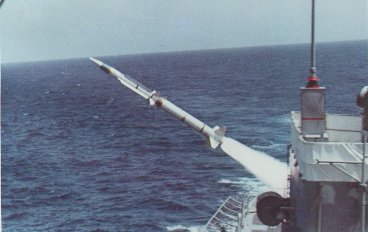General Dynamics (Convair) SAM-N-7/RIM-2 Terrier
The Terrier was the U.S. Navy's first operational shipborne medium-range surface-to-air missile. It was one result of the Bumblebee program, whose ultimate goal was the development of the SAM-N-6 Talos long-range surface-to-air missile. During devolpment of Talos, a Supersonic Test Vehicle (STV, CTV-N-8) was built to evaluate the guidance system at supersonic speeds. Because the results were promising, and the development of the complicated Talos would take many more years, it was decided to develop the STV into a tactical missile, the Terrier. The flight tests of the Terrier began in 1951, when the designation SAM-N-7 was also assigned. It took a few years to get the bugs out of the system, and the Terrier was not operational until 1956.
Production started with the SAM-N-7, but after a few rounds switched to the slightly reengineered SAM-N-7a Terrier 1a, soon to be known as Terrier BW-0 (Beam-riding, Wing-controlled, series 0). It employed a beam-riding guidance system, and used wings for flight control. It was powered by an Allegany Ballistics solid-fuel booster and an MW Kellogg solid-fuel sustainer motor. Terrier 1b was to be a version with repackaged electronics (designed by APL/Philco), but this was not produced. Another electronics redesign effort (initiated by BuOrd, designed by Motorola) resulted in the SAM-N-7c Terrier 1c version. This variant, later known as Terrier BW-1, had essentially the same characteristics as the BW-0, but was easier to produce and had higher reliability. The BW-0/1 versions were effective only against subsonic targets at altitudes up to 12 km (40000 ft).
The usage of suffix letters for the basic SAM-N-7 designation to distinguish between Terrier variants was short-lived, and was discontinued during the production of the BW-1. The Terrier was henceforth simply known as SAM-N-7 (and even that was rarely used), and the variants were designated by the suffixes BW-0, BW-1 (and others, which see below).
 |
| Photo: William J. O'Keefe |
| SAM-N-7 BW-1 (RIM-2B) |
The next version of the Terrier was the BT-3 (Beam-riding, Tail-controlled, series 3; series 2 was reserved for a motor improvement, which was not built). This missile had a new airframe, where the wings were replaced by fixed strakes, and the control surfaces were moved to the tail. The tail-control significantly enhanced the missile's agility. The BT-3 also had an improved autopilot and a new propulsion system (with a new sustainer, and an additional auxiliary solid-fuel power system) for higher speed and range. The first successful test was accomplished in 1954, and the BT-3 was operational in 1956. The improvements made the BT-3 effective against supersonic targets.
An improved version, called Terrier BT-3A, had a longer-burning charge for the auxiliary power system, and an end-burning sustainer, which doubled the missile range to about 37 km (20 nm). The BT-3A was also the first Terrier which could be used effectively in a surface-to-surface (anti-ship) mode. The BT-3A(N) was a nuclear armed BT-3A (the only nuclear Terrier version), which had a 1 kT W-45-0 warhead.
 |
| Photo: Ron Bigham |
| SAM-N-7 BT-3A (RIM-2D) |
The next development step was to change the beam-riding guidance to semi-active radar homing. The Terrier HT-3 used many components of the RIM-24 Tartar missile, which was itself essentially a short-range Terrier without booster. In 1957, the radar homing system for Terrier was tested with a converted wing-controlled missile, designated XHW-1. The production HT-3 used a C-band radar seeker. The SARH guidance greatly increased the effectiveness of the missile against low-flying targets.
In 1963, all variants of Terrier were redesignated in the RIM-2 series, as follows:
| Old Designation | New Designation |
|---|---|
| SAM-N-7 BW-0 | RIM-2A |
| SAM-N-7 BW-1 | RIM-2B |
| SAM-N-7 BT-3 | RIM-2C |
| SAM-N-7 BT-3A/-3A(N) | RIM-2D |
| SAM-N-7 HT-3 | RIM-2E |
As can be seen from this table, the old SAM-N-7 series designations did not use any suffix letters to designate variants.
The last Terrier variant was the RIM-2F, an improved RIM-2E. It had a new sustainer motor and power supply, which again doubled the missile's range, to about 75 km (40 nm). The RIM-2F was also known as HTR-3 (Homing Terrier, Retrofit). Additional improvements included solid-state electronics, improved ECCM, multiple-target ability, and improved anti-ship capability. Many RIM-2E missiles were brought up to RIM-2F standard.
Prodcution of the RIM-2 Terrier ended in 1966, after approximately 8000 missiles had been built. The RIM-2F was gradually replaced by the RIM-67 Standard ER missile, and the last Terriers were retired at the end of the 1980's.
Specifications
Note: Data given by several sources show slight variations. Figures given below may therefore be inaccurate!
Data for RIM-2B/D/F:
| RIM-2B | RIM-2D/F | |
|---|---|---|
| Length (incl. booster) | 8.25 m (27 ft 1 in) | 8.0 m (26 ft 4 in) |
| Wingspan | 1.20 m (47.3 in) | 0.61 m (24 in) |
| Finspan | 1.03 m (40.5 in) | 1.07 m (42.3 in) |
| Diameter | 0.34 m (13.5 in) | |
| Weight (w/o booster) | 480 kg (1060 lb); booster: 584 kg (1290 lb) | 535 kg (1180 lb); booster: 825 kg (1820 lb) |
| Speed | Mach 1.8 | Mach 3.0 |
| Ceiling | 12200 m (40000 ft) | 24400 m (80000 ft) |
| Range | 19 km (10 nm) | RIM-2D: 37 km (20 nm); RIM-2F: 75 km (40 nm) |
| Propulsion |
Solid-fueled rocket booster Solid-fueled rocket sustainer | |
| Warhead | 100 kg (218 lb) controlled-fragmentation warhead; RIM-2D (BT-3A(N)): W-45-0 nuclear warhead (1 kT) | |
Main Sources
[1] Norman Friedman: "US Naval Weapons", Conway Maritime Press, 1983
[2] Bill Gunston: "The Illustrated Encyclopedia of Rockets and Missiles", Salamander Books Ltd, 1979
[3] James N. Gibson: "Nuclear Weapons of the United States", Schiffer Publishing Ltd, 1996
Back to Current Designations Of U.S. Unmanned Military Aerospace Vehicles
Back to Directory of U.S. Military Rockets and Missiles
Last Updated: 24 March 2004